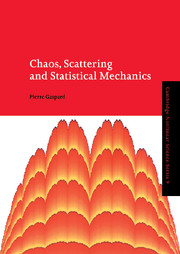Book contents
- Frontmatter
- Contents
- Preface
- Introduction
- Chapter 1 Dynamical systems and their linear stability
- Chapter 2 Topological chaos
- Chapter 3 Liouvillian dynamics
- Chapter 4 Probabilistic chaos
- Chapter 5 Chaotic scattering
- Chapter 6 Scattering theory of transport
- Chapter 7 Hydrodynamic modes of diffusion
- Chapter 8 Systems maintained out of equilibrium
- Chapter 9 Noises as microscopic chaos
- Chapter 10 Conclusions and perspectives
- References
- Index
Preface
Published online by Cambridge University Press: 30 January 2010
- Frontmatter
- Contents
- Preface
- Introduction
- Chapter 1 Dynamical systems and their linear stability
- Chapter 2 Topological chaos
- Chapter 3 Liouvillian dynamics
- Chapter 4 Probabilistic chaos
- Chapter 5 Chaotic scattering
- Chapter 6 Scattering theory of transport
- Chapter 7 Hydrodynamic modes of diffusion
- Chapter 8 Systems maintained out of equilibrium
- Chapter 9 Noises as microscopic chaos
- Chapter 10 Conclusions and perspectives
- References
- Index
Summary
Today, there is a growing interest in understanding the role of chaos in nonequilibrium statistical mechanics. Although ergodic theory has been one of the seeds of modern dynamical systems theory, it is only recently that new methods have been developed – especially, in periodic-orbit theory – in order to quantitatively characterize the microscopic chaos as well as the intrinsic rates of decay or relaxation of statistical ensembles of trajectories. One of these intrinsic rates is the escape rate associated with the so-called fractal repeller which plays a central role in chaotic scattering. During recent years, chaotic scattering has been discovered in many different fields, from celestial mechanics and hydrodynamics to atomic, molecular, mesoscopic, and nuclear physics. In molecular systems, chaotic scattering provides a classical and statistical understanding of chemical reactions. Chaotic scattering is also closely related to transport processes like diffusion or viscosity. In this way, relationships can be established between the transport coefficients and the characteristic quantities of microscopic chaos, such as the Lyapunov exponents, the Kolmogorov–Sinai entropy, or the fractal dimensions. These results and their developments shed new light on nonequilibrium statistical mechanics and the problem of irreversibility.
The aim of the present book is to describe the theory of chaotic scattering and this new approach to nonequilibrium statistical mechanics starting from the principles of dynamical systems theory and from the hypothesis of microscopic chaos. For lack of space and time, the book only contains results on classical dynamical systems, although many fascinating and closely connected results have also been obtained in the context of quantum dynamics.
- Type
- Chapter
- Information
- Chaos, Scattering and Statistical Mechanics , pp. xvii - xxPublisher: Cambridge University PressPrint publication year: 1998

